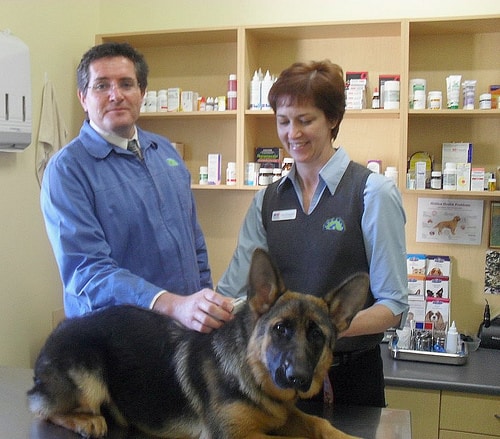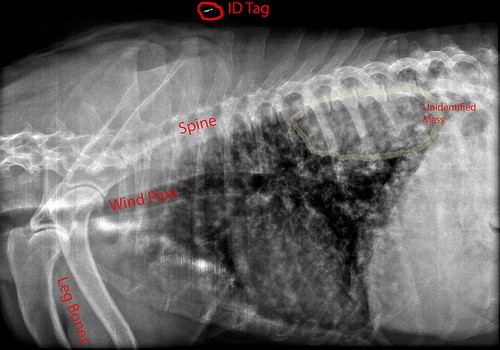Dogs
Cancer and Tumours in Dogs
Finding a lump on the skin or elsewhere on your dog can be a worrying time for an owner. Many tumours can be simply surgically removed by a veterinarian. In other instances, there may be a need for radiotherapy or chemotherapy for more malignant cancers. Costs for intensive treatment can be substantial, which makes it prudent to obtain a suitable pet insurance policy to help cover costs.
Cancer is a term to describe malignant neoplasms that affect the tissue surrounding the neoplasm. It can metastasize and travel to other parts of the body. Sometimes cancerous tissue can be removed and treated; however, it can also recur and be terminal for your pet.
A tumour is a tissue of abnormal growth of multiplying cells that serve no appropriate function in the body. Many tumours are benign.
Basal Skin Tumours in Dogs
Skin tumours are the most common form of dog cancer. Nearly 3 to 4 in 10 tumours affecting dogs are found on the skin. Fortunately, many of them are benign.
Older dogs and certain breeds like Poodles and Cocker Spaniels are likely to have basal cell tumours. A basal cell tumour can be stalked or broad at its base and are usually found around the head, neck and shoulders. There can be a pigmentation that people sometimes believe is melanoma.
Adenomas in Dogs
Adenomas of the ceruminous glands of the ears can resemble a chronic ear infection. Microscopic analysis will determine the diagnosis and treatment usually involves surgery and cancer treatments.
Cutaneous Hemangiomas in Dogs
Benign growths of the endothelial cells of the blood vessels can create benign growths referred to as cutaneous hemangiomas. Hemangiomas that originate in the subcutaneous layer usually show as a hairless blue-coloured bump. Surface hemangiomas will look more red or dark in colour. Hemangiomas are caused by various things and tend to affect dogs over a few years old.
Cutaneous Histiocytoma inDogs
Young dogs can be affected by benign canine cutaneous histiocytomas on the skin of the neck and head. They are caused by macrophages and monocytes in the skin and the tumour often regresses naturally. The lesions are hairless, round and reddish in colour.
Cysts in Dogs
With a lining of epithelial cells, cysts are not cancerous. The sac-like structure can form significant bumps on the skin at various parts of the body. The location of the cyst will often determine its name.
Fibroma in Dogs
A fibroma is a benign tumour formed from the connective cells called fibroblasts that commonly affect Doberman pinschers, Boston terriers, Boxers, Fox Terriers and Gold Retrievers. They are most likely found around the groin, flanks and limbs and often occur singularly. They can normally be surgically removed or if they are not causing any problems can be observed.
Epitheliomas in Dogs
The skin between the hair follicles of the legs, abdomen, neck and upper chest can give rise to intracutaneous cornifying epitheliomas. An epithelioma can secrete a thick substance. Treatment can involve removal and cancer therapies.
Trichoepithelioma affect the sheath of the hair follicle. They are often found on the limbs, head and tail in older dogs. They tend to exist as single lesions and can be hard and look like a cyst. Hair may disappear from the trichoepithelioma and it may ulcerate.
Lipomas in Dogs
Mature lipocytes or fat cells can grow to create lipomas. Lipomas often develop in the skin layers and form a soft lump that is pliable. They are usually located around the underside of a dog and often occur in spayed bitches. A lipoma may appear singularly or in clusters. Depending on how large the lipoma is and where it is located, a veterinarian may advise leaving it alone; however, surgery is best carried out when the lipoma is small.
Mast Cell Tumours in Dogs
A dog’s immune system contains mast cells to deal with inflammation and recovery after damage to tissues. Mast cells exist in the skin and terriers and Boxers appear to be more predisposed to developing mast cell tumours. Dogs with mast cell tumours may also have problems with intestinal and stomach ulcers. Around half of all mast cell tumours become malignant and all suspected mast cell tumours should have a biopsy taken and be considered for removal by surgical means.
Moles and Dogs
A mole (or nevus) occurs in the skin. Often they can be left along and do not require any medical intervention. If the mole becomes troublesome, then a veterinarian may elect to remove it.
Oral and Cutaneous Papilloma in Dogs
Caused by a virus, a papilloma occurring in the mouth is highly contagious between dogs. Younger pets are more likely to be infected. The virus will regress and the dog will build up immunity. Cutaneous papillomas are not caused by a virus. The tumour looks like a cauliflower and often grows around the eyes and head area as well as the feet.
Perianal Adenoma in Dogs
A tumour of the peranal glands that are located around the anus of the dog and also of the area around the tail, back, thighs are usually benign. Sometimes a perianal adenoma is referred to as a hepatoid gland tumour because the cells of the tumour look like liver cells. A perianal adenoma will affect male dogs that have not been castrated and are dependent on testosterone levels.
Tumours of the Sebaceous Glands in Dogs
Sebaceous glands produce lubricants to keep the skin and fur healthy. The oily substance helps with waterproofing and contains other chemical substances. Tumours of the sebaceous glands are common among Spaniels and look like cauliflowers or warts. If a dog presents with sebaceous gland tumours, and they are removed, it is possible for further tumours to occur elsewhere on the body of your pet.
Dogs and Skin Melanoma
Melanin is produced from melanocytes in the skin. Melanin is a natural pigment that gives the skin its colour. Melanomas of the skin are often benign, but can be malignant if they occur in the mouth or toes. Your pet may develop melanomas in other parts of the body. Melanocytes can develop into a melanoma that will need to me removed surgically.









